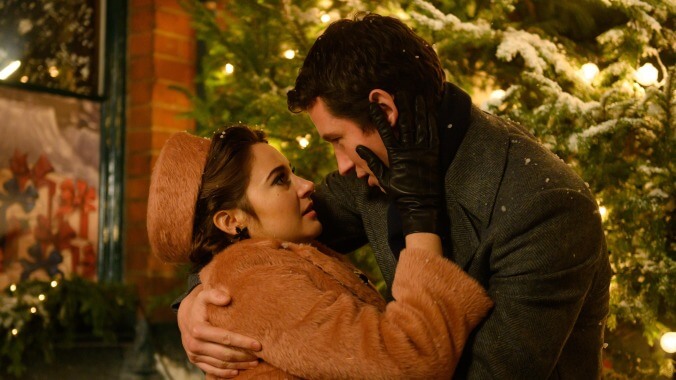English journalist Jojo Moyes is one such writer regularly denigrated with the “chick lit” label. Her romance novels—most centered on young white people with perfect faces, bound together by breathy sexual desire and soapy tragic twists—don’t reinvent the love-story wheel. But though they’re not critically acclaimed, these page-turners are very popular. Me Before You, for example, sold millions of copies, before going on to inspire a hit box-office adaptation starring Emilia Clarke and Sam Claflin. That’s the kind of success The Last Letter From Your Lover is hoping to replicate. Directed by Augustine Frizzell, best known for her 2018 indie stoner comedy Never Goin’ Back, the film is based on Moyes’ 2008 novel of the same name, which—unlike some of her other work—didn’t trouble The New York Times bestseller list. What the adaptation has going for it is two charismatic young stars, Felicity Jones and Shailene Woodley, pitching in to tell an enjoyable but extremely conventional story.
The film covers two timelines that eventually intersect. Jones plays Ellie Haworth, a journalist in London recovering from a messy break up who uncovers a series of secret love letters from the ’60s with the help of handsome colleague Rory (Nabhaan Rizwan). Woodley is letter writer Jennifer Stirling, an extraordinarily glamorous housewife, trapped in a loveless marriage, who develops feelings for the journalist assigned to write about her wealthy industrialist husband. Lover cuts between the two women, with Jennifer falling in love and Ellie opening herself up to the possibility.
We can only speculate as to what drew Woodley to this role, but one couldn’t begrudge her doing it simply for the incredible selection of hats she gets to wear (particularly after the internet’s reaction to those bangs in Big Little Lies). Jennifer’s wardrobe is a visual feast: bejeweled gowns, colorful tailored coats, perfectly coordinated accessories that compete with the loveliest stretches of Corsican coastline for our attention. Frizzell leans into this glamorous fantasy, with scenes of Woodley reclining on yachts resplendent in beaded lemon cocktail dresses and waking up from nights of passion with perfectly fanned false eyelashes.
Meanwhile, Felicity Jones’ Ellie has been frumped up to Bridget Jones levels, wearing cardigans of impressive shapelessness and rejecting nice men who like her just the way she is. Jennifer’s love story is the focus of the film, but there are a few fun moments that contrast the two romances, with Jennifer writing heartfelt pledges of undying love in exquisite calligraphy while Ellie agonizes over the correct number of “x”s to punctuate a text with. Final act contrivances aside, it’s hard to justify Ellie’s contribution to the narrative. She mostly serves as an audience surrogate to amp up enthusiasm for Jennifer’s story. The film seems to forget that it’s supposed to be unfolding through the letters, only returning to that structural device when narratively convenient.
Jones and Woodley do their best, forging reasonable chemistry with their unremarkable love interests (though inanimate objects would struggle to not spark with the latter, given how gorgeously done up she is here). Unfortunately, the romantic clichés in The Last Letter From Your Lover pile up unnervingly fast. Cars in the rain. Lusty glances across dinner tables. Amnesia. Declarations of love under balconies. Characters conveniently running into one another. If five more minutes were added to the film’s runtime, they would almost surely be devoted to someone racing to an airport gate or leaping into a lover’s arms in front of the Eiffel Tower.
The whole production is undeniably pleasant but also a little lazy, with dialogue that sags under heavy exposition. The impression is of a film unwilling to carve out its own identity or subvert any expectations, because it’s operating under the assumption that its target audience will be satisfied by well-worn conventions. Audiences should feel absolutely no shame in reaching for a little sweeping summer romance, or enjoying the cozy predictability of beautiful people falling into one another’s embrace. But they deserve a lovelorn cinematic attempt with boldness that doesn’t begin and end with hats.


